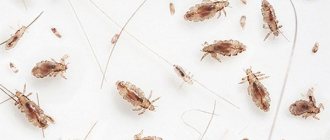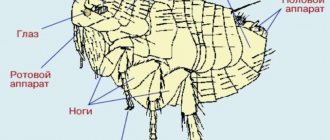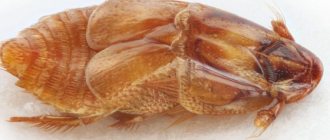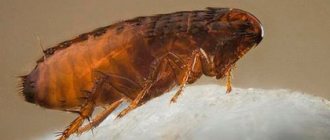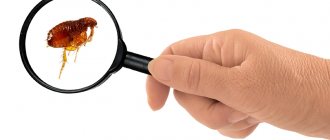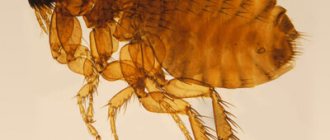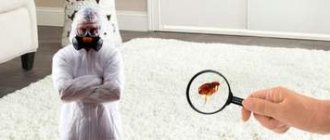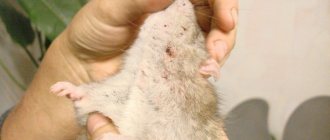A flea is a small blood-sucking insect that lives in the fur of animals. Despite the size of the pest, in reality it is very dangerous for humans and animals, as it is a carrier of many diseases (encephalitis, hepatitis, typhoid or plague). The parasite is perhaps one of the most jumping creatures in the world. Particularly striking is the flea's jumping technique, thanks to which the pest is able to jump in height to a distance many times greater than its size.
Myths about lice
There are several fundamentally erroneous opinions about the specifics of life activity and the methods of spread of skin parasites:
- Insects spread over a distance. The only way for parasites to move is to move with the host, his belongings, and clothes. Independent movement using your own resources is excluded.
- Insects jump or otherwise move quickly. The answers to this question were given above. Parasites are deprived of the ability to jump or perform active actions. They crawl slowly, but this is enough for the rapid spread of lice.
- The most common source of infection is animals. Lice are among the parasites that are not particularly selective when choosing a suitable food source. Humans, as the name suggests, prefer to attack people, but are capable of biting animals. Pets can act as a source of infection, but this rarely happens.
- Only children can get lice. This myth is probably the result of the fact that head lice is especially common in children's groups, for example, kindergartens and schools. Almost all people can be infected; the age factor is not important or significant. But since lice cannot jump, they quickly spread between children, because the latter use shared toys and often touch their heads when playing.
- Pediculosis is a disease exclusively of people who do not observe the rules of personal hygiene. This opinion is fundamentally wrong. Insects prefer clean skin, which greatly facilitates their access to a food source. But the use of detergents and perfumes that have a distinctly pungent odor makes them stay away; parasites cannot tolerate, for example, the strong aroma of essential oils of pine and citrus fruits.
- You can get rid of parasites through regular use of shampoos and other detergents. This measure will help reduce the number of lice, but it is impossible to completely get rid of them. This is due to the high resistance of nits to negative external factors.
Methods of disposal
Parasites cannot live permanently on the body, head, or hair of people. To avoid blood-sucking attacks, repellents are used. There are also various preparations for killing parasites that should be used to treat premises.
Sprays and aerosols
The most popular:
- Biban;
- Off-extreme;
- Gardex;
- Gall-Rat.
Aerosol Raptor is used to kill fleas in the house.
The insect repellent spray is distributed more evenly on the skin and clothing.
The aerosol helps to quickly get rid of parasites. The most popular is Raptor. Solfak, Tetrix, and Effective Ultra are also used.
After treatment, the home should be washed thoroughly to remove any remaining toxic substances. You cannot use the first disinfestation agent you come across, as this can lead to mutation of parasites, which will complicate further fight against them.
Folk remedies
When you cannot use chemicals, you can resort to folk remedies. A mixture of vinegar and water in equal parts is an effective protection against fleas. The solution is used to treat wooden surfaces.
Spraying the room with tansy tincture will help. This will repel and partially destroy the parasites.
You can treat your home against fleas with a kerosene solution.
Folk remedies for fleas.
A mixture of baking soda and salt in equal quantities is rubbed into the carpet and left overnight. They vacuum in the morning. The floor is treated with a solution of boric acid.
Insects are repelled by the smell of garlic. You can make your own homemade repellent by mixing garlic paste and brewer's yeast.
How to Get Rid of Fleas, Ear Mites and Ticks Naturally
How to tell if your pet has fleas
Your pet has been itching, but you're not entirely sure if he has fleas. Give her the white socks test. Place a white sock on your hand and run it over her coat, as well as her bedding and any carpet she frequently lies on. If you find small black specks on your sock, it's most likely flea droppings.
All natural flea treatment
If your pet definitely has fleas, you can get rid of them with a simple sea bath. Fill the sink or bathtub with water, then add plenty of salt. Stir until it dissolves, then bathe your pet in salt water. The fleas and their eggs will die.
Get rid of fleas while your pet sleeps
If your pet hates baths, try this bright idea. Near where your dog or cat sleeps, place Christmas lights or an unshaded lamp with a bowl of soapy water underneath. (Be sure to set it far enough away from your pet that he can't knock any of them over.) Fleas will be attracted to the warmth from the light and will jump towards it, most often landing right in the bowl of soap. water. Repeat this procedure every night for a week or until the fleas are gone.
Remove fleas from your home
Now that you've gotten rid of fleas from your pet, remove them from upholstery and carpets using a high-powered vacuum (ideally a canister). Remove the canister or bag and throw them outside once you're done. Next, prevent fleas with eucalyptus or lavender essential oil. In a spray bottle, mix a few drops of essential oil with 1 cup of water. Use it to spray your pet's bed and other parts of your home. Fleas pick up the scent of eucalyptus and lavender, so they should stay away. Do not use this spray undiluted or directly on your pet; Be sure to consult your veterinarian first.
How to get rid of ticks
You and your dog were just enjoying a fun romp through the woods, but you brought back a souvenir: ticks. To make it easier to remove them from your dog (or yourself!), first soak a Q-tip in rubbing alcohol. Apply it to the tick and it will loosen its grip. Then you can immediately remove the tick.
How to get rid of ear mites
Does your dog or cat constantly scratch their ears? He may have ear mites. After checking with your veterinarian, try this home remedy: Dissolve 1 teaspoon of baking soda in 1 cup of warm water and rub a cotton swab soaked in this mixture on your pet's ears. Repeat this procedure every day until your pet stops itching.
To learn more about all-natural remedies for fleas and other household pests, visit our pet tips board on Pinterest and follow us on Facebook for our tip of the day.
The suggestions offered here are for informational purposes only. The Authors and Publisher are not liable for damages arising from the use, attempted use, misuse or application of any suggestions contained on this website. Check with your veterinarian before trying any of these remedies.
Image Who knew?
Why are they dangerous?
It doesn’t matter what type of fleas has settled in the house: dog, cat or sand fleas - they are all sources of danger for people and pets. Insects are capable of relentlessly biting other creatures in the house until they are exterminated
At first, experts believed that a person could be a carrier of only one type of flea, “Pulex irritans,” but after more detailed research it became clear that any other types of similar insects could cause trouble for people.
This is what the fleas that live on the floors of our apartments look like
Of course, not every pest can survive on the human body, but cases of fleas surviving in conditions unusual for them are not very uncommon.
For man
This is what flea bites look like
Fleas pose a serious danger to people, and bites can have consequences:
- A sharp reaction of the body, expressed by the appearance of rashes near the bitten areas, enlarged lymph nodes, the appearance of allergic reactions, and increased body temperature.
- Severe itching, pain in the bitten areas.
- If you start scratching the bites, skin damage, suppuration and inflammation are possible.
- When neglected, wounds develop into pyoderma or ulcers.
- Severe pain from bites. In insects, the enzyme responsible for anesthetizing the bite site does not appear immediately, so young individuals bite painfully.
- The appearance of nervous disorders.
- Infections with serious infectious diseases.
For pets
Dogs most often carry the Ctenocephalus canis flea. Puppies become infected with insects from their mothers, mothers from neighboring dogs.
Dogs itch due to fleas
The most common reason for the appearance of insects on the body of animals is unsatisfactory living conditions for the pet. Sometimes fleas can appear due to poor nutrition.
The animal cannot be warned not to start scratching the bites. If you neglect your pet, dermatitis appears due to itching and scratching. Insects can serve as carriers of many dangerous diseases. The minimal harm is a strong desire to scratch the body until wounds appear.
Biology of the parasite
In nature, they live on the ground and visit their hosts only when feeding. Bloodsuckers can use humans as a food source, but they will not live on them. If fleas have chosen an apartment, they will lay eggs in separate corners that they like. Larvae emerge from them and feed on organic debris.
It becomes clear whether fleas live on people. They cannot spend a long time on the human body. Unlike a dog or cat, it has no fur, and there will simply be nowhere for it to hide. They can stay on the head in the hair for the longest time, but they won’t be able to live like that. Usually, having bitten their victim and received a dose of fresh blood, they leave their temporary “master” and return to the floor, to the litter or to a secluded corner.
JUMPING ANIMALS
Among the animals there are quite a few gifted jumpers. The African impala antelope makes magnificent jumps 10-12 meters long.
. In addition, her jump is quite high. Thanks to its exceptional jumping ability, the impala saves its life: when running away from a predator pursuing it, it does not turn in front of an obstacle in the form of bushes, but jumps over them in one jump, leaving the pursuer at a loss.
Puma
- a predatory cat from America, which is also called
a maneless lion
, jumps in height higher than all other representatives of its family - 4 meters.
However, lions and leopards
are not far behind her - the height of their jumps reaches 3 meters, and yet the animal often jumps with prey, which sometimes weighs as much as the predator itself.
Habitats
Fleas feed on the blood of animals, and live and lay eggs in dark places: carpet, basement, cracks, furniture, bedding, grass, booths, stones, and so on. They settle no higher than a meter in height, so the bites of people who discover them are located on the legs. They prefer beds and mattresses and go out hunting at night.
There are mainly two types of fleas that take root on dogs: the dog flea (Ctenocephalides canis) and the cat flea (Ctenocephalides felis). The most common is the cat one. Fleas are very dangerous.
Signs of a pest in an animal:
- anxiety and aggression;
- scratches and bites himself;
- red spots from scratching;
- When bathing, fleas jump off.
Without a food source, parasites can live up to two months. At this time, females cannot reproduce, as this requires fresh blood. If a dog or other object of hunger dies, then the fleas do not linger on them. They do not like high temperatures, but prefer dark, cool and damp places.
Nutritional Features
If there is a food source, fleas will feed daily. However, if necessary, they can live without food for several months. If we talk about what fleas eat, it mainly depends on the type of insect. For example, some suck blood excessively, for 20 to 60 minutes, and it remains undigested in their feces.
Others prefer to eat more often, but in smaller portions (these are, as a rule, those individuals that live in the nests of birds or rodents).
Insects for the most part do not become attached to any one victim - they can feed on the blood of different birds and animals.
However, there are those who prefer only one power source. The usual victims of such insects are bats.
Ways lice spread among people
Lice are highly specialized insects that are unable to survive outside their habitat. In life, in addition to “own” parasites, a person may encounter lice in pigs, dogs and cows.
People can only become infected with lice from another carrier of their own species. Since three types of lice live on humans, the way in which lice are transmitted depends on the type of lice. But lice have common features, thanks to which some methods of transmission of insects from person to person are completely excluded.
How lice are transmitted from person to person with head lice:
- close contact of the head of a healthy person with the head of an infected person;
- using someone else's hat;
- accidental fall of a parasite from a patient’s head onto the hair of a healthy person in public transport;
- movement of lice from one person to another when sharply shaking the hair;
- using someone else's comb, towel and other personal hygiene items.
Ways of infection by parasites A child at school or in kindergarten is highly likely to become infected with lice through someone else's hat, since children like to exchange hats. Adults can become infected with parasites in a crowd at a rally or during wild dancing in a nightclub.
Where do they live?
Fleas are hardy and virtually invulnerable insects that adapt well to various environmental conditions. This partly explains the fact that fleas' habitat includes all continents. The habitats of most species of parasites are temperate and subtropical zones, but fleas live even in Antarctica, parasitizing local inhabitants - penguins and seals.
Some species do not leave the host's body, others live in nests and burrows, and others settle in the ground or on grass. Fleas often live next to people, living in basements and even apartments. In most cases, at home they parasitize pets, but sometimes they also attack people. In rare cases, fleas can even settle on a person’s head, hiding in the hair.
How do insects spread?
Individuals always live in places with large crowds of people. The risk category includes residents of dormitories, camps, boarding schools, etc.
Head louse
The transmission of insects to humans occurs as follows:
- Creatures move from one personality to another through close interaction.
- Insects also spread through household items, ending up on the body of their victims.
- Individuals spread through the use of common things, especially hats.
- Occasionally, bloodsuckers live on bedding, from where they move to other people.
It is worth realizing that parasite carriers are persons with any number of insects on their head and body, even single ones. With a high intensity of damage, the likelihood that individuals will fall on furniture increases. Accordingly, the risk of infection increases significantly.
They are able to survive in an aquatic environment for about two days. Moreover, different species, both body lice and head lice, conduct their vigorous life activity here. In this way, you can also become infected with cercariasis, the symptoms of which must be known in order to correctly establish the diagnosis.
It is worth saying that nits rarely act as a source of infection. Lice pose a great danger to others. Now let's figure out whether lice can jump.
Standing long jump technique
Desire alone is not enough to learn how to jump effectively. First you need to learn the technique of long jump from a place or from a run.
Preparation before take-off
Taking the starting position is an important stage that allows you to concentrate and concentrate all your strength. Unlike the running long jump, here the initial phase is the starting line.
That is, it is necessary:
- with your feet shoulder-width apart, stand at the starting point;
- move your arms slightly behind your back (back), and lower them down with your elbows bent;
- bend the hip and knee joints at the level of the socks;
- fix your feet without lifting them off the ground.
Repulsion
The first repulsion should occur immediately after preparation. If you delay your readiness at this stage, then you will no longer be able to perform a long jump correctly from a standing position. Indeed, at this moment the torso begins inertial movement.
At the same time, during the shock period you need to have time to:
- make a sharp lunge with your hands in front of you;
- tighten the hip joints;
- straighten your legs (knees) at the joints;
- rise sharply from the ground.
Flight and landing
Correctly executed flight and landing will allow you to jump far.
During the flight you must:
- stretch your whole body to a straight line, smoothly straightening your knees;
- Before landing, lower your arms and bring your feet forward.
Contact with the surface should be easy and smooth for the jumper. For balance, knees are bent and arms are brought forward. This helps prevent injuries to the joints and their ligaments. When landing, you need to straighten up.
In addition, there are two important rules that will help you overcome the maximum distance when jumping from a standing position:
- the body should be at an angle of 45 degrees;
- You cannot land on perfectly straight legs and feet.
Fleas living on animals
Fleas that live on our pets live on their bodies only when they feed on blood. The rest of the time they can live and reproduce on bedding, upholstery, in soft toys for animals, in corners and crevices of the floor, under baseboards, in garbage, in sawdust, where favorable conditions are created. Adults wait for an animal or person passing by and jump on it, clinging to clothing or fur. Fleas that parasitize animals are dangerous because they carry (in addition to microbes and viruses) helminth eggs. The difficulty of disinfecting an apartment in which animals constantly live is the need to treat animals twice with lower concentration insecticides before and after insectization. Animals are processed according to their weight and age. There are many specialized products and preparations for controlling animal fleas:
- special shampoos – rid the animal of living parasites on the body;
- insecticidal sprays - destroy adult insects and repel new ones, but require rinsing after 2-3 hours of exposure;
- flea collars - used after treating an animal and prevent a new attack by small jumping insects;
- insecticidal drops - applied to the withers, and in case of severe infection, along the entire spine, and are not washed off.
When treating premises, special attention is paid to dog and cat bedding, where there can be a high concentration of not only adults, but also larvae and flea eggs. Toys that pets play with are occasionally washed or washed in hot water with detergents that are safe for the animals themselves.
Anti-flea sprays justify their use before a long walk in the forest, park, or in animal walking areas, where the pet runs the risk of picking up “other people’s fleas.”
How to remove parasites using folk remedies
The effectiveness of folk remedies in treating fleas in a dog is no lower than the effectiveness of pharmaceutical drugs, but treatment will take longer.
Traditional methods of treatment:
- dry twigs of wormwood are laid out around the house in different places, this will repel insects;
- a decoction of wormwood is used to bathe the animal;
- with a tincture of onion and garlic, the wool is treated in those places where the dog cannot lick the product: on the spine and withers;
- an infusion of celandine is applied drop by drop to the dog’s spine throughout the day;
- wool can also be treated with a solution of tansy, eucalyptus, juniper and lemongrass;
- On the bedding where the animal sleeps, you can apply small quantities of eucalyptus, mint, lavender or cedar essential oil. Oils can also be used to bathe your pet;
- a solution of soda and salt (one to one) is rubbed into the carpets of the room where the dog lives;
- tar soap is used to bathe the animal;
- Citrus fruit peels are laid out in the kennel or on the bedding where the animal sleeps.
Swap meet
This is the name of flea markets where they sell all sorts of things that have been used or are simply not useful. And this name came from France. It is believed that this is where such a market first appeared. They called it Flea because the items they sold were swarming with all sorts of insects.
Such trading places are still considered breeding grounds for unsanitary conditions. There is a risk that the purchased new item will bring ectoparasites into the house, which will then have to be quickly removed. Therefore, after purchasing such a thing, you need to at least wash it with tar soap.
Read more about methods of combating the parasite in the articles in the “Fleas” section. Subscribe to our page on social networks and be the first to know about updates to the STOP Parasites sections of the website.
What chemicals to use
Not all flea products sold are effective enough. Preference should be given to those containing the following substances:
- Pyrethrin.
- Pyrethroid.
- Imidacloprid.
- Nitenpyram.
- Selamectin.
- Fipronil.
In addition to these modern and practically harmless insecticides, there are others that have been used for many decades and have long proven their effectiveness.
We are talking about products created on the basis of organophosphorus compounds:
- Chlorophos;
- Chlorpyrifos;
- Karbofos;
- Dichlorvos.
They, however, have one, but quite significant flaw - high toxicity
Therefore, they should be used with great caution. Advantage (besides efficiency) – low price
Among other quite effective drugs, it is worth mentioning the products supplied to the market under the Raptor brand. Many of them are produced in the form of aerosols and, according to consumer reviews, are quite effective. They are created on the basis of a modern insecticide - cypermethrin. This substance has no unpleasant odor and is completely harmless to both humans and pets.
Another manufacturer, Raid, is also very popular among Russians. Aerosols are made on the basis of the same cypermethrin. Of the entire range, the most effective is the drug that destroys both cockroaches and ants.
Description of insects
The insects' body is smooth and equipped with spines that help them cling to their prey. Fleas have 3 pairs of legs; the rear ones are longer and provide jumping ability. Insects are good jumpers, so they fly to the victim without direct contact.
Body length – 3 millimeters, color – brown. The compressed sides allow for easy movement between hairs. They usually live outside the human body, visiting for food. They jump quickly, up to 50 centimeters. It is difficult to catch and crush an insect.
The eggs are thrown in small batches in different places, sometimes on the host. Larvae hatch, similar to worms, which actively move, live in garbage and dust, and feed on organic debris there.
Physiology
They feed on the blood of warm-blooded creatures, including humans. They can live near people or animals, hiding almost all the time when they are not looking for food.
They live up to 500 days, but usually much less. If they don't find people, they terrorize domestic animals.
Why are they dangerous?
The main threat lies in the diseases that fleas spread. Among the most significant and likely:
- salmonellosis;
- hepatitis;
- helminthiases;
- tick-borne encephalitis.
Even if infection does not occur, many people suffer from skin irritation, peeling, and loss of appearance. Often, especially in children, allergic reactions are added. Unpleasant neighbors can seriously ruin your life, leading to neurosis.
What does a bite look like?
The bite site is a small red bump that rises slightly above the skin. With a large number of wounds, they resemble a large rash. If scratched - swelling of the skin, abraded areas of the epidermis, redness.
Distribution routes
The human flea takes a liking to empty rooms near humans. They live in close proximity and are brought in mainly by the person himself on clothes, shoes, things from the attic or closet.
Fleas move well on their own, they sense where they can feed, so they try to live nearby. They easily migrate from the extreme floors of houses to apartments.
Signs of the presence of a parasite
If fleas have settled down to live in an apartment, it is impossible not to detect their traces. Household members are covered with red spots and itch. Small eggs are easy to spot in different places. Although the tracks resemble those of mosquitoes, flying squeakers are usually detected immediately.
Danger to humans
Despite its microscopic size, the flea is a fairly dangerous insect. Her saliva contains substances that can cause allergies and even anaphylactic shock in some people. As a result of a parasite bite, itching appears, and scratching the affected area can lead to suppuration or local inflammation. If proper treatment is not started, ulcers may appear on the surface of the skin.
But still, the main thing that makes fleas dangerous is the fact that with frequent changes of “hosts” the insects carry very dangerous diseases, including:
- salmonellosis;
- pseudotuberculosis;
- anthrax;
- typhus;
- encephalitis;
- brucellosis;
- plague.
Of course, the risk of contracting some kind of infection after a flea bite is low, but it does exist. Moreover, the causative agents of various diseases that live in the blood of parasites persist for quite a long period.
Appearance and structure of fleas
Small jumping bloodsuckers have a fairly characteristic appearance and, even despite their small size, are easily distinguished from other insects. They have a narrow, laterally flattened body 2-5 mm long. Its color is brown, almost black, the surface of the chitinous shell is smooth and shiny. Under a microscope, you can see individual spines and hairs on the flea’s body:
The legs of the last, rear pair are significantly enlarged and have powerful muscles. Thanks to them, these small insects are able to jump far, as a result of which they easily move between shelters in an apartment, and in case of danger they jump so quickly that the jump itself is not noticed by the human eye.
The eyes of fleas are simple, almost non-functional. Fleas receive basic information about the environment using small antennas and a special sensory organ capable of detecting air vibrations.
Moreover, a flea that bit a person today could have fed on a rat or dog a few days ago. And on her body, in her mouth or intestines, there may be viruses and bacteria that she collects from all her food sources.
The oral apparatus of fleas is of the piercing-sucking type; it is equipped with special bristles with which the insect easily pierces the skin. However, due to the relatively small size of the jaws, the flea is forced to literally plunge its head into the skin in order to reach a blood vessel:
Fleas feed mainly during the day, so they can easily be seen jumping around in an apartment during daylight hours. When attacked, the insect usually makes several bites at a distance of 1-2 cm from each other. Usually their traces are lined up in a chain, which is why they can sometimes be confused with bedbug bites.
Slobbering Penny
The common slobber, or slobbering frog (lat. Philaenus spumarius) is an insect belonging to the family of pennine cicadas (lat. Aphrophoridae). This small (5-6.7 mm) insect outdid the flea itself. Scientists have been able to establish that the pennix is capable of jumping to a height of 60-70 cm.
At the same time, the speed of the cicada’s separation from the surface is about 3.1 m per second, which is 3 times faster than that of its predecessor. Just imagine that if this insect became the size of a person, it could easily jump over a skyscraper. Impressive, isn't it?!
For some living creatures, jumping is a common way of movement, for others it is a lifeline, but for most of them it is another way to overcome all sorts of obstacles. Without this skill, many of them would have had a hard time.
Flea biology
The flea is, in its own way, an “extraordinary parasite.” Her habits regarding living conditions and nutrition are unusual. It mainly parasitizes warm-blooded animals, these include birds and mammals, but there are varieties of fleas that also bite cold-blooded animals (reptiles), which is still not the rule, but the exception.
The flea is called a nest-burrow parasite, this is due to the fact that the most favorable climate is created for them in the homes of birds and animals. The fact is that fleas do not live on their prey permanently. Once full, they can spend some time in the fur or feathers of their owner, after which they leave their feeding area. At the same time, they are always nearby, be it a doghouse, a rodent hole or a bird’s nest, where the presence of a victim in them is a guarantee for the flea that the food will be received on time.
If there is someone for a flea to parasitize, then the insect will feed daily. But this does not mean that without eating they will die. A flea can remain without food for quite a long time, sometimes from several weeks to three months. After such abstinence, the parasite rushes at its victim with redoubled force.
Considering this circumstance, a person is best suited for a flea to play the role of a victim, especially if he does not maintain the hygiene of his home.
Representatives of different types of fleas have distinctive features associated with food intake. It is enough for one type of ectoparasites to receive food once a day, but at the same time, they suck in such an amount of blood that they are not able to digest it (this can be seen from the waste of their vital activity). Eating can last from 1 minute to several hours. If the flea's habitat is an animal's nest or burrow, the parasite can receive food several times during the day, absorbing a small amount of blood at a time.
Fleas have such a specific feature - they change their owner. This property does not apply to bat fleas, where the parasites feed exclusively on the blood of a given individual.
Fleas can be found in all corners of the earth: in European countries, in Asia, in Africa and even in Antarctica. To maintain their life cycle, these parasites require a temperature of +18 to 27 degrees. They die when the air heats up to +45 degrees and when the thermometer drops to -15. Unfavorable temperatures for them can be compared to the use of an insecticide.
Reproduction and life cycle
Fleas need food and a favorable environment to reproduce successfully. Sexual intercourse occurs when the female climbs onto the male's back. He retracts his genital claw into the spermatic receptacle and receives the sperm.
The fertilization process takes about 15 minutes, but sexual intercourse can last several hours.
Immediately after fertilization, the female lays eggs. It does this in small broods of 10–15 eggs. The flea forcefully pushes out the eggs, which scatter in different directions.
Consequently, competition between hatched larvae is reduced and they have a better chance of survival.
The flea development cycle includes 4 stages:
- egg - develops in 5 - 14 days depending on temperature and humidity;
- larva - a translucent worm emerges from the egg and undergoes three molts, in each of which it increases in size;
- pupa - the flea larva hides in a cocoon, where its further development occurs from 2 weeks to a year (at this time the insect does not need nutrition and is resistant to external conditions and mechanical influences);
- imago (adult) - having been born, immediately begins to look for a victim.
how high and how far, jump speed
Fleas Flea jump
A flea is a small blood-sucking insect that lives in the fur of animals. Despite the size of the pest, in reality it is very dangerous for humans and animals, as it is a carrier of many diseases (encephalitis, hepatitis, typhoid or plague). The parasite is perhaps one of the most jumping creatures in the world. Particularly striking is the flea's jumping technique, thanks to which the pest is able to jump in height to a distance many times greater than its size.
Peculiarities
The parasite has a characteristic appearance, as a result of which it can be easily distinguished from other insects. Its flattened body, narrow on the sides, is covered with a chitinous shell of a black-brown hue. The pest has three pairs of limbs, the hind ones of which are the longest. It is thanks to these greatly enlarged and powerfully muscled legs that the flea jumps very high.
Parasite Jumping Characteristics
What is also surprising is how far a flea can jump. After all, the average size of the parasite is only 2-3 mm. However, a flea's jump in height can reach up to 0.3 m, while the bloodsucker can jump 0.18 m in length - a distance exceeding its size by more than 100 times. The speed of the flea at the beginning of the jump is no less impressive, and it is about 1.9 m/s.
Parasites especially use this method of movement when there is danger, jumping so quickly that people sometimes cannot even understand whether fleas are jumping or crawling. This unique ability is also necessary for insects to find prey.
Adults living in open space lay eggs not only in animal fur, but also on the ground itself. The offspring that appear after a while are forced to make jumps, going in search of a warm-blooded host - a source of food. Since fleas jump very high and with great speed, they very quickly find a suitable object for themselves in the form of a person or animal.
What to do if there are parasites in the house
Now, when asked whether fleas jump, we can confidently answer that they jump quite high. That is why the fight against fleas should begin as quickly as possible.
First of all, it is necessary to establish the source of infection. Then treat the room and the animal living in the house
It is important to consider how high fleas jump, so walls should be treated at waist level.
Not only carpets or rugs are at risk, but also sofas, beds, and even soft toys. It is necessary to carry out wet cleaning regularly, using a decoction of wormwood to wash surfaces. Bed linen, blankets and bedspreads should be washed regularly and, if possible, heat treated.
Prevention is the main guarantor of protection against bloodsuckers
It is important to prevent your four-legged pets from interacting with stray animals; after visiting the street, they should be thoroughly combed and collars for cats and dogs should be used.
(2 ratings, average 5 out of 5)
How black fleas appear in the house
Adult fleas live on domestic and wild warm-blooded animals - mammals and birds, and lay eggs there. Animals in the process of life scatter flea eggs everywhere they move and rest. The emerging larvae live and feed in the environment until they develop into mature fleas.
Adult parasites enter the home from the street on the fur of pets, on wild city rats and mice, or on human clothing. Sometimes residents bring home flea eggs or larvae on their shoes along with street dust. If there are animals, fleas multiply rapidly in the apartment. Two to three weeks after an accidental infestation, the owners notice that mature young black fleas are jumping around the house, and begin to wonder what to do about this problem.
The risk of parasite infection is also associated with moving to a new place of residence, because you do not know in advance how things were with the previous residents. As a rule, new residents learn about an unwanted inheritance only when they feel black earth fleas biting their feet. But 90% of the pest population in the home is made up of invisible stages - eggs, larvae and pupae - that don't bite. And if the owners notice the infection by their bites, it means that soon the next generations of black fleas will attack them with renewed vigor.
Fleas breed en masse in damp basements of multi-storey buildings, where rats, mice, stray cats and dogs live. During outbreaks of infection in such foci, residents of the lower floors suffer from parasites. In private country houses, the source of fleas is wild animals that accidentally wander into the yard or even into the house.
Spiders
In a jumping spider, blood rushes to the legs, which helps them stretch and lift off the surface of the earth. Jumping spiders are well known for their unusual skills. This could easily be guessed from their name. These tiny arthropod creatures launch themselves into the air, sometimes from relatively high surfaces.
Angelika Varum decided to learn a new sport during the New Year holidays
Licorice root neutralizes coronavirus, but should be taken in moderation
Abnormal temperature: Sochi broke a record set half a century ago
Unlike grasshoppers, jumping spiders, like fleas, do not have legs with muscles. In fact, they do not even have the function of extending their legs at two joints. Instead, spiders use blood pressure to move their legs quickly. Scientists have found that the muscles in the spider's body contract and instantly force blood (actually hemolymph) to flow to the legs. The increase in blood flow causes the legs to expand and the spider to float in the air for a moment.
Standing triple jump
This exercise is fundamental during athletics competitions.
The triple jump technique is characterized by the following stages:
- Pushing off with both legs at the same time and flying. The actions are similar to classic standing jumps. Throw one leg out in front of you, bending it at the knees. In this case, the shin should look slightly forward and be lowered down. The other leg performs the function of holding back. After landing, bring the second (back) leg forward, thus preparing for the second stage.
- Pushing off a second time and taking off again. Actions are performed similarly to the first push, with “raking” movements.
- The third, final push before the main flight. The pushing leg should pull up to the fly leg, bend at the knee and move as close to the chest as possible.
- Flight from a standstill and a successful landing. Having first lowered the fly leg to the ground, then the other and stood on the starting line, you need to immediately perform the jump, trying with all your might to lengthen the soaring phase in the air.
To achieve results, the swing movements must be performed lightly, and the thrusts before hovering must be strong and elastic.
Types of fleas, distinctive features
Entomologists say that there are about 2 thousand species of fleas, and these are those fleas that parasitize one type of warm-blooded animal. The average person is unlikely to distinguish a dog flea from a fox flea. This difference can be seen using optical instruments. Scientists studying them can understand the diversity of flea species without a microscope.
The most common types of fleas are:
– The human flea – writers in literary works and in the paintings of artists in the Middle Ages captured the image of a human flea. Take, for example, the high hairstyles of the ladies of that time, which they wore for several months and were treated with lamb fat for durability. They certainly infested with fleas, and to catch them you had to put a flea trap inside your hair. – The cat flea is the most popular among fleas; it can parasitize humans, felines and dogs. They are capable of inflicting multiple bites, unlike their counterparts.
– Rat flea – this flea carries the most serious danger, spreading infectious deadly diseases, such as plague. – The dog flea is one of the above, it is quite large in size and leads a quiet lifestyle, parasitizing mainly on dogs.
This is only a small fraction of the number of flea species that exist on earth. In fact, any genus of mammals is a carrier of its own species of flea.
List of little-known facts about fleas
And if even a schoolchild knows how many legs a flea has, then the following information will surprise even big biology buffs.
- Fleas were mentioned in the Bible.
These blood-sucking parasites were given several lines in the Bible. In the book of Samuel, King Saul took 1,000 men to meet David, who said, “Who are you fighting against, king of Israel?” Who are you chasing? A dead dog, or one small flea? Additionally, verse 26:20 reads, “Do not let my blood be shed on the land far from the presence of the Lord, for the king of Israel has gone out in search of a certain flea, and is pursuing it as if he were hunting partridges in the mountains.”
- Arthropods have a muscle under their hind legs that contains a substance called resilin.
Resilin is the most elastic substance known to mankind. If you could make a ball from rubber and throw it with all your might at a wall, it would bounce off it almost 30 meters. It is this protein that makes fleas such good jumpers.
- There is a breed of dog bred specifically for fleas.
Some sources indicate that in the Middle Ages people got lap dogs for only one purpose: to distract fleas from themselves.
Fluffy dogs were kept near them by court ladies and their gentlemen in fluffy wigs infested with parasites. Fleas were indeed much more willing to bite small dogs (after all, animal blood is much more appetizing than human blood).
- The flea is the most efficient and tireless jumper.
Thanks to resilin, arthropods can jump almost 100 times their height. This is comparable to the fact that a person would jump 500 meters from a standstill! However, insects do not feel tired at all from such loads and can make up to 300 jumps without stopping.
- Arthropods gain speed faster than space shuttles.
Can they run?
And so, we already know that ticks do not see where they are going, but they feel it very well. They can safely be classified as very slow insects, since under normal conditions they are absolutely in no hurry and move quite slowly. If we talk about the speed of movement in conditions of hunger, then we should rely on research data.
These studies were conducted to find out not only the speed of movement, but also the purposefulness of movement. In other words, does it actually move in the direction of its victim, how much does it accelerate, and how does it affect the speed of various kinds of obstacles?
It was possible to find out that the tick really knows where it is going and if it senses a victim, it moves only towards the food source. Also, during the experiment, it was possible to find out that the speed of movement is influenced by the road itself; if it is a well-established path, then he will arrive at the goal much faster. If we talk about numbers, then, for example, to cover a path of 120 meters, the parasite will need 2 days, but these periods can increase up to 3 months.
When he does not sense a power source, he sees no point in moving and can only crawl a little higher to find a convenient place to hunt. When the parasite is completely saturated with blood, it does not move. But in stressful situations, his ability to move increases significantly. When he hears danger, he can cover a distance of 1 meter in 10 seconds.
How long do they live?
Flea species, environment and living conditions significantly affect life expectancy. Fleas can live from 2–3 months to 2 years. Dry air and heat shorten the life of the insect.
So, at air temperatures above +30, the life cycle is almost halved - the insect simply dries up. At lower temperatures, the development of the parasite slows down, which means it lives longer.
Oddly enough, even the absence of an owner does not shorten the life of fleas. They can go without food for a long time (several months), they simply become less active and stop reproducing.
Under normal conditions (optimal temperature, humidity and adequate nutrition), fleas most often live about 2–2.5 months.
